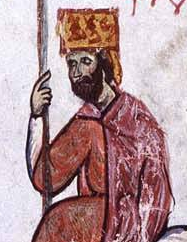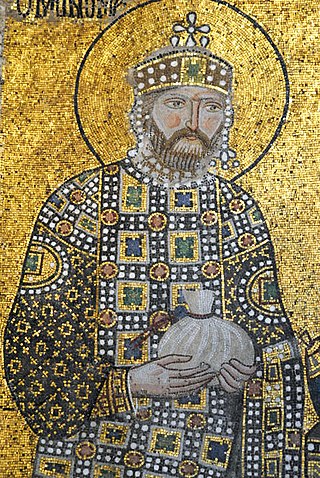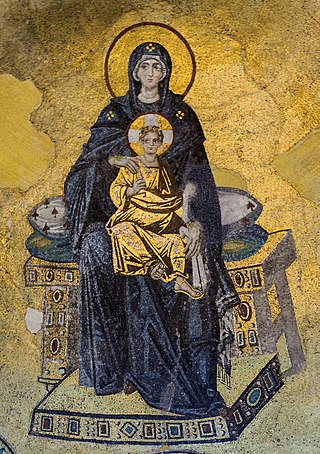
Alexios I Komnenos, Latinized Alexius I Comnenus, was Byzantine emperor from 1081 to 1118. Although he was not the first emperor of the Komnenian dynasty, it was during his reign that the Komnenos family came to full power and initiated a hereditary succession to the throne. Inheriting a collapsing empire and faced with constant warfare during his reign against both the Seljuq Turks in Asia Minor and the Normans in the western Balkans, Alexios was able to curb the Byzantine decline and begin the military, financial, and territorial recovery known as the Komnenian restoration. His appeals to Western Europe for help against the Turks was the catalyst that sparked the First Crusade.

Photios I, also spelled Photius, was the ecumenical patriarch of Constantinople from 858 to 867 and from 877 to 886. He is recognized in the Eastern Orthodox Church as Saint Photios the Great.

Basil I, nicknamed "the Macedonian", was Byzantine emperor from 867 to 886. Born a lowly peasant in the theme of Macedonia, he rose to prominence in the imperial court after entering into the service of Theophilitzes, a relative of Emperor Michael III. He was given a fortune by the wealthy Danielis and gained Michael's favour, whose mistress he married on his emperor's orders. In 866, Michael proclaimed him co-emperor, but Basil ordered his assassination the next year, thus installing himself as sole ruler of the empire. Despite his humble origins, he showed great ability in running the affairs of state, and founded the Macedonian dynasty. He was succeeded upon his death by his son Leo VI.

Romanos III Argyros, or Argyropoulos was Byzantine Emperor from 1028 until his death. He was a Byzantine noble and senior official in Constantinople when the dying Constantine VIII forced him to divorce his wife and marry the emperor's daughter Zoë. Upon Constantine's death three days later, Romanos took the throne.

Romanos IV Diogenes was a Byzantine general and Akritai commander who, after his marriage to the dowager empress Eudokia Makrembolitissa, was crowned Byzantine emperor. He reigned from 1068 to 1071, during which time he was determined to halt the decline of the Byzantine military and to stop Turkish incursions into the Byzantine Empire. In 1071 he was captured and his army routed at the Battle of Manzikert by the forces of Alp Arslan.

Michael III, also known as Michael the Drunkard, was Byzantine emperor from 842 to 867. Michael III was the third and traditionally last member of the Amorian dynasty. He was given the disparaging epithet the Drunkard by the hostile historians of the succeeding Macedonian dynasty, but modern historical research has rehabilitated his reputation to some extent, demonstrating the vital role his reign played in the resurgence of Byzantine power in the 9th century. He was also the youngest person to bear the imperial title, as well as the youngest to succeed as senior emperor.

Michael IV the Paphlagonian was Byzantine Emperor from 11 April 1034 to his death on 10 December 1041.

Staurakios, also called Stauracius, was Byzantine emperor from 26 or 28 July to 2 October 811. He was born in the early 790s, probably between 791 and 793, to Nikephoros I and an unknown woman. Nikephoros seized the throne of the Byzantine Empire from Empress Irene in 802, and elevated Staurakios to co-emperor on 25 December 803. On 20 December 807, a bride show was held by Nikephoros to select a wife for Staurakios, which resulted in his marriage to Theophano of Athens, a kinswoman of Irene. Little else is known of him until he came to take the throne upon the death of Nikephoros.

Zoë Porphyrogenita was a member of the Macedonian dynasty who briefly reigned as Byzantine empress in 1042, alongside her sister Theodora. Before that she was enthroned as empress consort or empress mother to a series of co-rulers, two of whom were married to her.

Leo VI, called the Wise, was Byzantine Emperor from 886 to 912. The second ruler of the Macedonian dynasty, he was very well read, leading to his epithet. During his reign, the renaissance of letters, begun by his predecessor Basil I, continued; but the empire also saw several military defeats in the Balkans against Bulgaria and against the Arabs in Sicily and the Aegean. His reign also witnessed the formal discontinuation of several ancient Roman institutions, such as the separate office of Roman consul.

Constantine IX Monomachos reigned as Byzantine emperor from June 1042 to January 1055. Empress Zoë Porphyrogenita chose him as a husband and co-emperor in 1042, although he had been exiled for conspiring against her previous husband, Emperor Michael IV the Paphlagonian. The couple shared the throne with Zoë's sister Theodora Porphyrogenita. Zoë died in 1050, and Constantine continued his collaboration with Theodora until his own death five years later.
Nicholas III Grammatikos or Grammaticus was an Eastern Orthodox patriarch of Constantinople (1084–1111).

Theodotos I Kassiteras, Latinized as Theodotus I Cassiteras was Ecumenical Patriarch of Constantinople from 1 April 815 to January 821.

Macedonian Renaissance is a historiographical term used for the blossoming of Byzantine culture in the 9th–11th centuries, under the eponymous Macedonian dynasty (867–1056), following the upheavals and transformations of the 7th–8th centuries, also known as the "Byzantine Dark Ages". The period is also known as the era of Byzantine encyclopedism, because of the attempts to systematically organize and codify knowledge, exemplified by the works of the scholar-emperor Constantine VII Porphyrogennetos.
Cosmas I of Constantinople was Patriarch of Constantinople from 2 August 1075 to 8 May 1081.
George Palaiologos or Palaeologus was a Byzantine aristocrat and general. One of the earliest known ancestors of the Palaiologos dynasty, he was a capable military commander who played a critical role in helping his brother-in-law Alexios I Komnenos seize the throne in 1081. In subsequent year he played an important role in Alexios' campaigns, especially the Battle of Dyrrhachium against the Italo-Normans or the Battle of Levounion against the Pechenegs, and was a major source used by Anna Komnene in her Alexiad.
Euthymius Zigabenus or Zigadenus or Zygadenus was a 12th-century monk and commentator on the Bible. He was a friend of the Byzantine emperor Alexius I Comnenus, for whom he wrote a lengthy work on heresies, Panoplia Dogmatica or Panoply of Doctrine. This began in the apostolic era and continued down to the Bogomils, some of whom he personally examined. The entry on the Bogomils is our main source of information about them. Nothing is known about his life.
The tzykanisterion was a stadium for playing the tzykanion, a kind of polo adopted by the Byzantines from Sassanid Persia.
Eustratius Garidas was Ecumenical Patriarch of Constantinople between 1081 and 1084. A monk, he was elevated to the patriarchal throne through the influence of the mother of the emperor Alexios I, Anna Dalassene, to whom he had become an intimate advisor. He was an eunuch.

The Byzantine Empire was ruled by emperors of the Doukas dynasty between 1059 and 1081. There are six emperors and co-emperors of this period: the dynasty's founder, Emperor Constantine X Doukas, his brother John Doukas, katepano and later Caesar, Romanos IV Diogenes, Constantine's son Michael VII Doukas, Michael's son and co-emperor Constantine Doukas, and finally Nikephoros III Botaneiates, who claimed descent from the Phokas family.